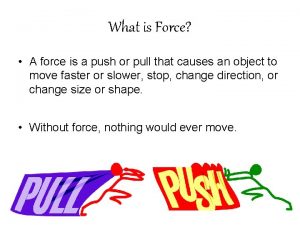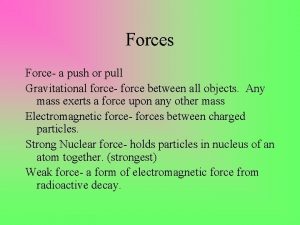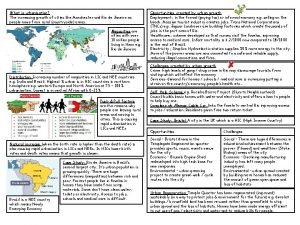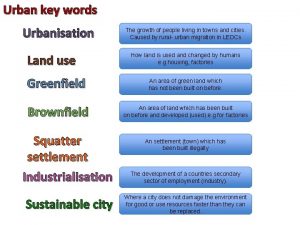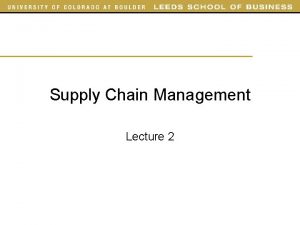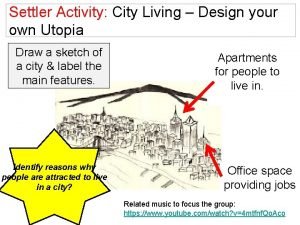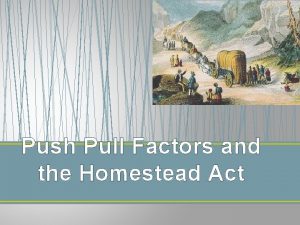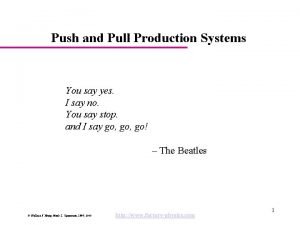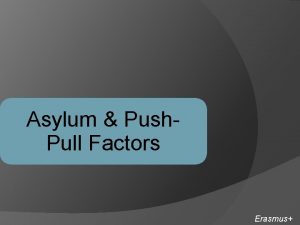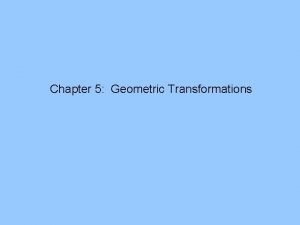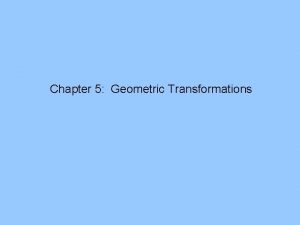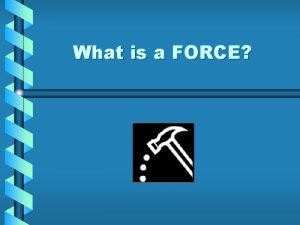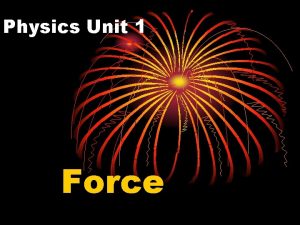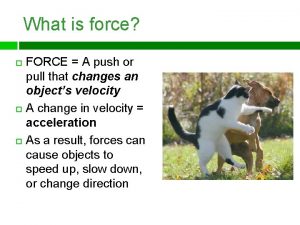Define Force Force a push or pull on


















- Slides: 18

Define Force • Force: a push or pull on an object resulting from the object’s interaction with another object • Forces only exist as a result of interactions • Net Force: the total combination of two or more forces acting on an object Which of these interactions would require you to calculate a net force?

Categories of Forces • Contact Forces: force that results from two objects touching each other • Long-range force: forces still applicable when objects are not touching • Can you name an example of each type of force? • Equilibrium: when the net force is zero

Types of Forces Force Symbol Definition Direction Friction Ff The contact force that acts to oppose sliding motions between surfaces Parallel to the surface and opposite the direction of motion Normal FN The contact force exerted by a surface on an object (also called a support force) Perpendicular to and away from the surface Spring Fs The push or pull exerted by a spring Opposite the displacement of the object attached to the spring Tension FT The force applied by a string, rope, or cable when attached to a body and pulled taut Away from the object and parallel to the string, rope, or cable at the point of attachment Thrust Fthrust A term used to describe the force used in rockets, planes, etc. In the same direction as the acceleration of the object Weight Fg A long range force due to the attraction of two masses Straight down toward the center of mass

Gravity Which of these two men will have a greater Fg? • Because Earth is by far the largest object that is close to you, Fg typically measures the force of attraction between you and the planet • The more mass an object has, the greater the attraction between that object and the planet

Calculating Fg • Previously: g = 9. 8 m/s 2 • Newton’s 2 nd Law: F = ma • If g is a form of acceleration, what formula should we use to calculate Fg? • Fg = mg • Measured in pounds in the English system, we will measure all forces (including Fg) in Newtons!!

Gravity examples • What is your weight in N if 1 pound = 4. 45 N? • Barry: 205 lbs = 912. 3 N • If this is your weight in Newtons, what is your mass in kg? • Fg = mg • 912. 3 N = m (9. 8 m/s 2) • m = 93. 1 kg

Showing Forces • Force Diagram: a visual representation of all of the forces acting on an object • IMPORTANT: be sure to show forces acting in the correct directions (Types of Forces table)

Force Diagrams • Example #1: draw a force diagram for a car as it drives down the road Example #2: draw a force diagram for a runner as they go for a jog

Newton’s 1 st Law • “Law of Inertia” • An object at rest will remain at rest unless acted on by an unbalanced force. An object in motion continues in motion with the same speed and in the same direction unless acted upon by an unbalanced force • Inertia: ability of an object to resist change in its state of motion

Newton’s 2 nd Law • Acceleration is produced when a force acts on a mass. The greater the mass, the greater the amount of force needed to accelerate. • F = ma • F is force in Newtons • m is mass in kg • a is acceleration in m/s 2 • Means that heavier objects require more force to move


Example • An automobile with a mass of 1000 kg accelerates when the traffic light turns green. If the net force on the car is 4000 N, what is the car’s acceleration? • USE THE 3 STEPS!!

Newton’s 3 rd Law • For every action there is an equal and opposite re-action • This means that for every force there is a reaction force that is equal in size, but opposite in direction. That is to say that whenever an object pushes another object it gets pushed back in the opposite direction equally hard

Friction • A force that is exerted as two objects in contact move past each other • Typically resists motion • Different materials have different amounts of this resisting force

Types of Friction • Friction acts differently when an object is standing still than when an object is moving • Static Friction: the force that resists the initial movement of an object • Kinetic Friction: the force that continues to resist the movement of an object once it is already moving • Static friction will always be greater than kinetic friction. This is because it is harder to start an object moving than it is to keep it moving

Coefficient of Friction • The coefficient of friction is a numerical representation of the amount of friction between objects • Because different materials produce different amounts of friction, these coefficients depend on the two substances in contact

Calculating Friction • We Know: Friction is dependent on the materials in contact with each other • What other factors could determine how much friction will slow down the motion of an object? • Does the amount of the object present matter? How would we measure this? • Note: reactionary forces are typically calculated using other reactionary forces if another force is necessary for the calculation • How would you calculate the force of friction? ? ?

Calculating Friction • Ff = μFN • Reminder: Fg = FN in most cases • Two calculations may be necessary: • Static friction (using μS): force that must be overcome to begin motion • Kinetic friction (using μK): force that must be worked against for continuous motion
 Magnetic force push or pull
Magnetic force push or pull Gravitational force push or pull
Gravitational force push or pull Angle of pull
Angle of pull Push and pull factors of urbanisation
Push and pull factors of urbanisation Push and pull factors of urbanisation
Push and pull factors of urbanisation Centripetal movement geography
Centripetal movement geography Curitiba sustainable city
Curitiba sustainable city Collaborative supply chain
Collaborative supply chain Strategie promocji
Strategie promocji Push and pull factors of urbanisation
Push and pull factors of urbanisation Push and pull scenarios
Push and pull scenarios Homestead act easy definition
Homestead act easy definition Pull production system
Pull production system Push vs pull promotional strategy
Push vs pull promotional strategy Marketing objectives examples
Marketing objectives examples Push pull profile strategies marketing communications
Push pull profile strategies marketing communications Technology push example
Technology push example The great tug of war
The great tug of war Kanban push pull
Kanban push pull
